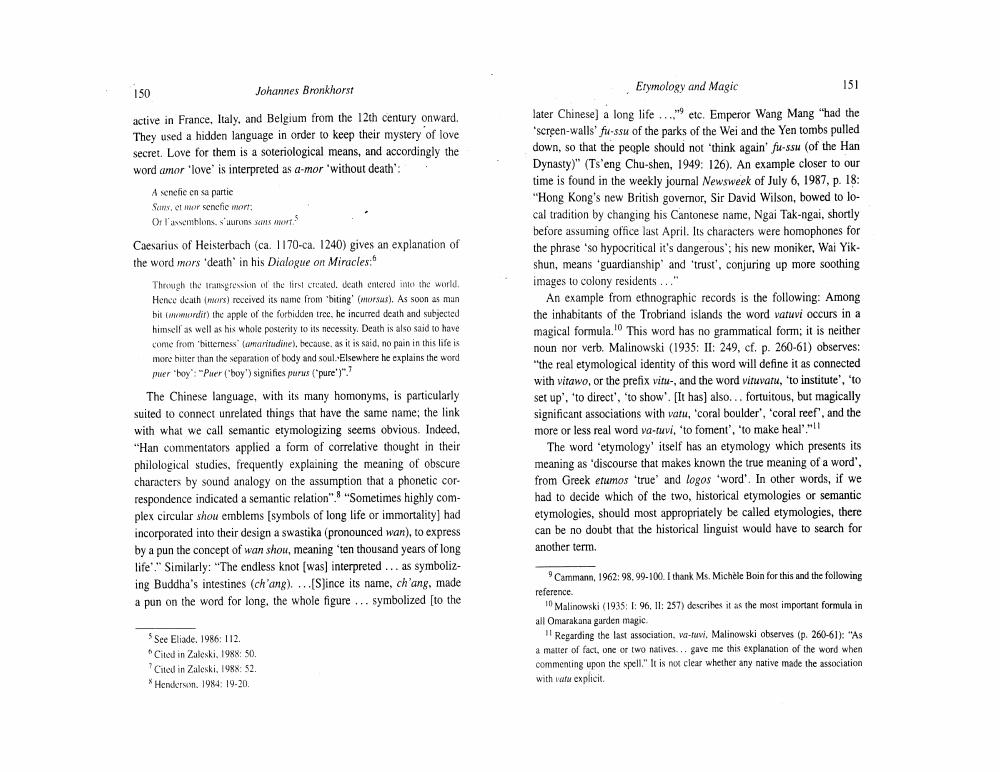Book Title: Etymology And Magic Yaskas Nirukta Flatos Cratylus And Riddle Of Semanticetymologies Author(s): Johannes Bronkhorst Publisher: Johannes Bronkhorst View full book textPage 3
________________ 150 Johannes Bronkhorst active in France, Italy, and Belgium from the 12th century onward. They used a hidden language in order to keep their mystery of love secret. Love for them is a soteriological means, and accordingly the word amor 'love' is interpreted as a-mor 'without death': A senefie en sa partie Sans, et mor senefic mort Or l'assemblons, s'aurons sans mort. Caesarius of Heisterbach (ca. 1170-ca. 1240) gives an explanation of the word mors 'death' in his Dialogue on Miracles: Through the transgression of the first created, death entered into the world. Hence death (mors) received its name from 'biting' (morsus). As soon as mun bit tomordir) the apple of the forbidden tree, he incurred death and subjected himself as well as his whole posterity to its necessity. Death is also said to have come from 'bitterness" (amaritudine), because, as it is said, no pain in this life is more bitter than the separation of body and soul. Elsewhere he explains the word puer "boy": "Puer ("boy") signifies purus ("pure")".? The Chinese language, with its many homonyms, is particularly suited to connect unrelated things that have the same name; the link with what we call semantic etymologizing seems obvious. Indeed, "Han commentators applied a form of correlative thought in their philological studies, frequently explaining the meaning of obscure characters by sound analogy on the assumption that a phonetic correspondence indicated a semantic relation". "Sometimes highly complex circular shou emblems [symbols of long life or immortality] had incorporated into their design a swastika (pronounced wan), to express by a pun the concept of wan shou, meaning 'ten thousand years of long life." Similarly: "The endless knot [was] interpreted... as symbolizing Buddha's intestines (ch'ang). ...[S]ince its name, ch'ang, made a pun on the word for long, the whole figure... symbolized [to the 5 See Eliade, 1986: 112. Cited in Zaleski, 1988: 50. Cited in Zaleski, 1988: 52. *Henderson. 1984: 19-20. Etymology and Magic 151 later Chinese] a long life.... etc. Emperor Wang Mang "had the 'screen-walls' fu-ssu of the parks of the Wei and the Yen tombs pulled down, so that the people should not "think again' fu-ssu (of the Han Dynasty)" (Ts'eng Chu-shen, 1949: 126). An example closer to our time is found in the weekly journal Newsweek of July 6, 1987, p. 18: "Hong Kong's new British governor, Sir David Wilson, bowed to local tradition by changing his Cantonese name, Ngai Tak-ngai, shortly before assuming office last April. Its characters were homophones for the phrase 'so hypocritical it's dangerous'; his new moniker, Wai Yikshun, means 'guardianship' and 'trust', conjuring up more soothing images to colony residents..." An example from ethnographic records is the following: Among the inhabitants of the Trobriand islands the word vatuvi occurs in a magical formula." This word has no grammatical form; it is neither noun nor verb. Malinowski (1935: II: 249, cf. p. 260-61) observes: "the real etymological identity of this word will define it as connected with vitawo, or the prefix vitu-, and the word vituvatu, 'to institute', 'to set up', 'to direct', 'to show'. [It has] also... fortuitous, but magically significant associations with vatu, 'coral boulder', 'coral reef', and the more or less real word va-tuvi, 'to foment', 'to make heal","l The word 'etymology' itself has an etymology which presents its meaning as 'discourse that makes known the true meaning of a word', from Greek etumos 'true' and logos 'word'. In other words, if we had to decide which of the two, historical etymologies or semantic etymologies, should most appropriately be called etymologies, there can be no doubt that the historical linguist would have to search for another term. 9 Cammann, 1962: 98, 99-100. I thank Ms. Michèle Boin for this and the following reference. 10 Malinowski (1935: I: 96, 11: 257) describes it as the most important formula in all Omarakana garden magic. Regarding the last association, va-tuvi, Malinowski observes (p. 260-61): "As a matter of fact, one or two natives... gave me this explanation of the word when commenting upon the spell." It is not clear whether any native made the association with varu explicit.Page Navigation
1 2 3 4 5 6 7 8 9 10 11 12 13 14 15 16 17 18 19 20 21 22 23 24 25 26 27 28 29
